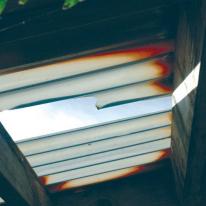Translucent sheet roofing – cracked sheets
Listed under: Roof, cladding, fixings and hardware, fixings, roof cladding, translucent sheets
Cause
Impact damage or weight on sheets
Repair
- most translucent sheet roofing is not designed to support foot traffic or dead weight and should not be walked on or have objects stored on it. Older translucent sheet roofing may also have become brittle from a long time of UV exposure
- because translucent sheet roofing is only used over open areas of houses (decks, verandahs, entrances, covered walkways, carports) it does not have the same weathertight requirements as ordinary roofing. If the cracks are not obvious and have no effect on the use of the space beneath them, action may not be required, or you could experiment with using an appropriate sealant on the cracks to stop the rain getting through
- if the cracks are visually unacceptable, or they allow rain to get through to the area beneath, then some or all of the sheets may need to be replaced. If the sheets have yellowed or become opaque with age, replacing all of them may be the best option
- there is a wide range of products on the market. The traditional translucent profiled sheet roofing, typically with a corrugated profile, is still available. Flat acrylic sheets that look like glass, but weigh a lot less than glass, are also available. Both of these are produced in clear acrylic (which allows the greatest transmission of light and heat) as well as grey or bronze tints that reduce the light and heat passing through
- the roofing comes with aluminium extruded accessories (rails, end caps, span bars etc.) and flashings folded from aluminium or galvanised steel
- the roofing usually requires a roof pitch no less than 3° and no more than 30°
- some manufacturers say their sheeting will expand/contract up to 5 mm per metre on temperature changes. Installation instructions address this. Tapes are provided for under the sheeting to reduce creaking sounds
- follow the installation instructions of the manufacturer
- clean translucent roofing with warm soapy water and a soft cloth. This may not be sufficient for lichen – follow the manufacturer’s recommendation
Cause
Fixings are too tight
Repair
- as in the repair above. Make sure to follow the roofing manufacturer’s instructions, to use the fixings they specify and to install them in the way they describe
Cause
There are insufficient expansion and contraction allowances at fixing points
Repair
- as the first repair above noted, sheeting can expand/contract up to 5 mm per metre with temperatures changes. Make sure to follow the roofing manufacturer’s instructions, to use the fixings they specify and to install them in the way they describe





